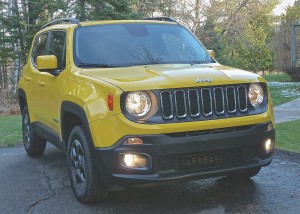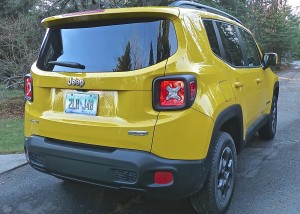Renegade Carries Jeep to Wordly Crossover
Filed under: Equinox, Weekly test drives, Autos
By John Gilbert
Jeep, by itself, is the most-recognized name in automotives — all over the world. It is, of course, best-known in the U.S., but it also carved out a name and reputation in Europe and in Asia when it was created in 1941 to help the good guys win World War II.
Currently, the Jeep brand spans a wide range from rugged off-roading to luxury country clubbing, with the Wrangler climbing rocks and the Grand Cherokee carrying you and your guests to the fancy party. The latest addition to the Jeep line is the Renegade, and it adds a new dimension because it is so hopelessly cute that it is attractive, even though cute fairly shouts that it can’t be rugged. Then it proves it is more rugged than anyone could have guessed, as it hauls its cute little compact and boxy shape up rocky cliffs and over terrain that you’d never think of attempting in an ordinary lifespan.
As if to emphasize how popular Jeep is worldwide, the Renegade came into being with full encouragement from Fiat, which is handy, because Fiat owns Chrysler, which owns Jeep. How much Fiat backs the Renegade might best be explained by the fact that Fiat used an Italian plant to build the Renegade, with plans to sell it in Europe as well as in the U.S. and all around the world.
Fiat has returned to the U.S. with the cute subcompact 500, and it offers a hot-rod version of it with a high-tech “MultiAir” 4-cylinder engine bolstered by a turbocharger that turns it into a fun and dashing little pocket-rocket. At the same time, Chrysler, Dodge and Jeep have been using a modified version of a joint-venture 2.4-liter 4-cylinder originally designed by Hyundai when that South Korean company barged into the high-tech end of automotives five or six years ago.
When the Fiat MultiAir system was explained to me, it is a system that uses a series of oil-filled tubes connecting the intake and exhaust valvetrain. It would be a dual-overhead-camshaft system, except that there is only one cam; the other is replaced by the valves on one cam operating the valves on the other side directly, via the compressing of the oil tubes.
Instead of being complex, it is innovative enough to allow almost infinite overlap for expansive valve timing. Chrysler and Fiat engineers told me that the MultiAir system would work to improve any engine, so I continued to pester them to prove it by installing it on an engine other than the 1.4-liter Fiat. So they did.
All of which brings us back to the Renegade. You can choose from two engines in the lightest of Jeep off-roaders. First is the 1.4-liter MultiAir turbo engine — right out of the Fiat Abarth. It delivers 160 horsepower and 184 foot-pounds of torque, and comes with a 6-speed stick shift. The other engine is the 2.4-liter “Tigershark” 4-cylinder equipped with MultiAir2 technology on the valvetrain, and it is coordinated with a smooth-shifting 9-speed automatic, offering 160 horsepower and 184 foot-pounds of torque. Read more




 John Gilbert is a lifetime Minnesotan and career journalist, specializing in cars and sports during and since spending 30 years at the Minneapolis Tribune, now the Star Tribune. More recently, he has continued translating the high-tech world of autos and sharing his passionate insights as a freelance writer/photographer/broadcaster. A member of the prestigious North American Car and Truck of the Year jury since 1993. John can be heard Monday-Friday from 9-11am on 610 KDAL(www.kdal610.com) on the "John Gilbert Show," and writes a column in the Duluth Reader.
John Gilbert is a lifetime Minnesotan and career journalist, specializing in cars and sports during and since spending 30 years at the Minneapolis Tribune, now the Star Tribune. More recently, he has continued translating the high-tech world of autos and sharing his passionate insights as a freelance writer/photographer/broadcaster. A member of the prestigious North American Car and Truck of the Year jury since 1993. John can be heard Monday-Friday from 9-11am on 610 KDAL(www.kdal610.com) on the "John Gilbert Show," and writes a column in the Duluth Reader.